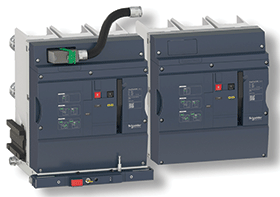

Circuit breakers are undoubtedly one of the unsung heroes of the electrical world. They perform vitally important tasks, protecting an electrical circuit from damage caused by overcurrent/overload of short circuit. In short, they interrupt current flow as soon as the protective relays detect a fault.
The above alone makes a solid case for why circuit breakers require maintenance and, importantly, diagnostics. However, to place it in everyday context, it’s important that we take one step back and look at some of consequences of faulty breakers.
Foremost, when circuit breakers start to break in a plant or factory, this can lead to various problems, primarily downtime. Moreover, if there are no spare parts available, the situation can be even more problematic. Replacing a breaker, especially an older one, is a time-consuming task that involves changing several connections, resulting in significant downtime.
This downtime doesn’t just affect the faulty breaker; it can have a cascading effect on other systems, causing additional failures and disruptions. In the current energy provision landscape, extended downtime should be avoided at all costs.
Fortunately, there are a number of expert service providers that offer both the entrenched auditing experience and diagnostics tools that ensure crucial components like circuit breakers are managed and maintained. In fact, diagnostics are emerging as a critical success factor in improving electrical room safety, durability and performance. Proper electrical equipment diagnostics requires a high level of human experience and expertise, sophisticated software tools, and broad access to equipment field performance data.
The question is what should you look for when choosing the right diagnostic offering? Breaker diagnostic tools assess the speed of particular breakers over time, and whether they have slowed down, highlighting which ones should be repaired or replaced outright. These diagnostic tools also provide detailed information and recommendations that will allow organisations to plan for the future. They can determine how long a breaker can still be used, and offer scenarios that outline what parts will still be available in the next ten years. They also generate reports that include data from visual inspections, and technical data from the various tests conducted on the breaker to assess its condition.
Schneider Electric’s ProDiag diagnostic tools offer a combination of dedicated sensors and internal software that allow services personnel to analyse trip units, relays, breakers, fuses and other electrical components. Its ProDiag Breaker tool identifies the symptoms of undetected incidents or degradation of equipment and offers the following additional benefits:
• Detects the early stages of breaker degradation, which aren’t necessarily detected during regular preventive maintenance.
• Assists with protection of downstream electrical distribution equipment, goods, and the people operating them.
• Enhances reliability, mitigating unexpected shutdown risks and operating costs.
• Extends equipment lifespan, optimising TCO.
| Tel: | +27 11 254 6400 |
| Email: | [email protected] |
| www: | www.se.com/za/en/ |
| Articles: | More information and articles about Schneider Electric South Africa |

© Technews Publishing (Pty) Ltd | All Rights Reserved